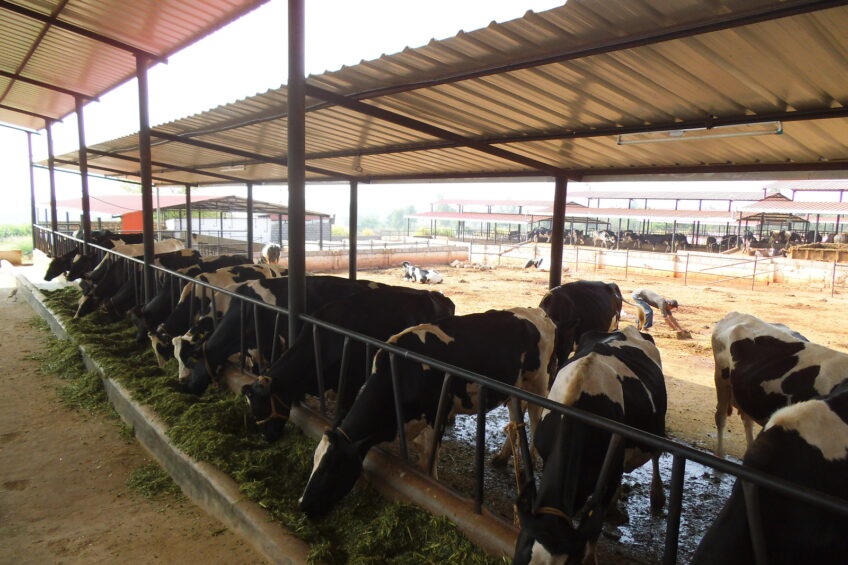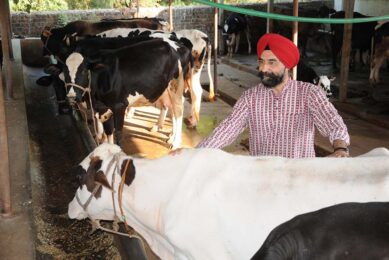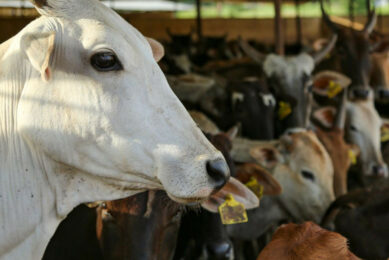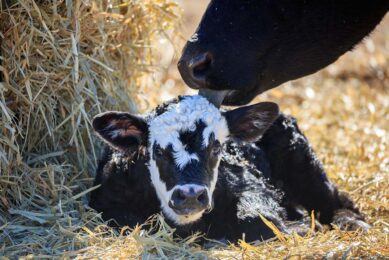Dairy farming sector in India experiences a rapid growth

Dairy production in India will experience a brisk growth in the coming years. The increase in production arises from traditional small family farms. In addition, new companies are emerging. Mechanisation and automation are at a low ebb in both types of farm. How rapidly this will change mainly depends on price and the availability of labour.
There is a strong increase in the demand for milk in India, partly due to the growing number of inhabitants. The country is expected to count 1.5 billion inhabitants by 2035. Population growth in India is exceeding that of China, thus resulting in a larger population in India than in China by 2030. Dairy consumption is also increasing per capita. This is mainly due to the growing middle class. In 2011-2012 the milk supply was 290 grams per day per capita. As a result of better living conditions and a recovering economy the increasing demand for dairy products in India is expected to exceed production.
“Yet, it is questionable if India will emerge as a major dairy importer. The country has an extensive range of import restrictions. The fact that regional authorities are responsible for regional trade disputes makes it more complex,” says Bram Prins, chairman of the Global Dairy Farmers (GDF). GDF is a platform for leading dairy farmers, with a restricted number of companies, from all over the world to meet each other for the discussion of new strategies, as a reaction to new policy measures, legislation and market developments. Last month Prins visited India to explore the opportunities and possibilities the developing dairy farming industry has to offer. He combined this with a visit to the VIV India, a trade fair at which GDF presented itself with a stand.
No concern
Concerning the good opportunities for growth of dairy consumption in India, dairy sector expert Prins says, “In India milk is a product that does not pose a problem or concern to any religion. It is sought-after by both Hindus and Muslims; two important population groups in the country.” GDF-chairman Prins expects that the increasing dairy consumption in India will have to be mainly supplied by a further extension of the domestic milk production. “International dairy companies are also moving in this direction. FrieslandCampina, for instance, made plans to take over Parag Milk, one of the country’s largest dairy enterprises,” Prins says.
“Patterns of change in the Indian dairy industry can be understood by following trends in other developing dairy markets. While India is unlike any other market – it will also develop its dairy industry to consolidate, to improve efficiency and to improve production,” says Marty Philippi, International Business Development manager at the Canadese equipment manufacturer Jaylor. Philippi visits India frequently. “Some recent activity in India by the multi-national dairy processors will ignite interest in improvements etc. The Indian dairy industry will expand but any venture into the market should have a commitment to the longer term.”
Backward integration
As the Indian dairy sector is highly fragmented, so called backward integration by increasing the supply after the takeover of dairy companies, is not a simple matter. A large part of the country’s dairy sector consists of small scale farms with two to eight cows. This farm category accounts for well over 80% of the national milk production. “These family farms are a key part of the rural social system. Without these small farms there wouldn’t be employment for all of those who live in the countryside,” says Katrien van ‘t Hooft of DutchFarmExperience. She is engaged in international knowledge diffusion in the area of stock farming and visits India on a regular basis. Van ‘t Hooft identifies milk quality as a point of concern. This is related to hygiene during milking, lack of cooling and udder health issues associated with antibiotic use. “The larger dairies deal with more than 300,000 suppliers. Such numbers make it difficult to sufficiently guide individual dairy farmers to better quality of milk. Using discounts on the farmer’s price to force them not to use antibiotics is an option, but when cattle die from it, then the situation will be even worse.” Van ‘t Hooft works closely with several Indian dairies to look out for opportunities to improve animal health and milk quality with a combination of Indian and Western knowledge.
This spring Prins visited several dairy farms in India. He noted that there is a great potential for improvement in the field of milk quality. “A focus on and safeguarding of quality is still in its infancy,” says Prins. “For instance, there was no milk cooling system on the farms we visited, including the large farms. On the other hand, raw milk reaches the consumer on the very day of production.” According to Prins the Indian dairy industry knows an increasing demand for milk means complying with higher standards.
Upscaling
The Indian government has been stimulating the development of dairy farming in India for decades. This policy mostly aims for growth of family companies. Scaling up companies with three to five cows to five to 10 cows is the current trend. In addition to the growth of these family farms, in India few large dairy farms arise. Foreign investors barely play a role in this.
Labour needs
Prins from GDF points out the need for labour per cow at the newly arising larger dairy farms is equal to that of small family farms. “There is hardly any mechanisation. We saw a mixer wagon at one farm, but that was an exception. Almost all large companies we visited employ many employees. Generally it concerns complete families. They manually feed and water the cattle. Also manure is manually removed. Modern milking parlours do not exist. Large farms have one central space cows gather to be milked. Milking is done with the help of vacuum line and milk barrels.”
Prins also expects a change in the Indian dairy sector will occur, which will lead to an increased productivity. “But it is very difficult to predict when this change will come. On other emerging economies, such as China, we saw a movement of people from rural to urban areas. Also in India at a certain point the supply of cheap labour will decrease. Only then upscaling will take on more extended forms, and dairy farms will seek en masse for possibilities to use mechanisation and automation in order to decrease the need for labour per kilogram milk,” says Prins.
Potency
Van ‘t Hooft notes that within existing companies in the Indian dairy sector a large potential exists to produce milk of a better quality. “Throughout the world family farms in the dairy sector perform best. This type of farm offers the best possibilities to provide animals with the individual attention they need. Indian family farms offer important scope for development. Average milk production is often less than 1,500 kilograms milk per cow. Improvements in ration and management can bring significant improvements. As the situation currently is by no means ideal, antibiotic use in the Indian dairy sector is very high.”
According to Van ‘t Hooft, the fact that the Indian government more or less obligates dairy farmers to breed Holstein cattle is a major bottleneck. “Breeding with Holstein once can lead to fine results, but pure Holstein cows are unable to cope with the Indian conditions. Indian dairy farmers must be given the opportunity to breed robust cows with local breeds.”
Local talent
Foreign companies currently have a hard time entering the Indian market as supplier of the dairy sector. “Business culture in India is not the same as in the EU and America. Companies need to utilise local talent and local acumen to achieve the necessary trust and relationships in Indian business community,” says Philippi from Jaylor. Jaylor is a manufacturer of Fodder wagons of various sizes ranging from 10 cows to 10,000 cows. “We have products that can work for the Indian market.” Philippi is acquiring a network within the Indian dairy sector and hopes to sell mixer wagons there in the coming years, although he expects he will need to display staying power. “The five to eight cow farms don’t have the means to afford this kind of equipment. Larger farms are finding interested investors but the current number is low and spread over five regions.”
A problem for companies like Jaylor is that the distribution channels are poorly and inadequately established and supported. “Farmers indicated a real challenge to improvement being the after sales support and parts required to sustain the dairy. This issue was apparent for many of the recognised industry leaders of equipment,” says Philippi. “The lack of quality distribution could also be caused by the Indian economic and business models that exist.”
According to GDF chairman Prins, there is no doubt companies from outside India will play a role in the further development of the dairy sector in India. “At some point the strong growth in demand for good-quality milk will create room for the international business world to contribute to upscaling, production efficiency and milk quality improvement. The usage of modern techniques and knowledge will allow milk production in India to double over the next 30 years.”
Many small companies
The Indian dairy sector produced 134.5 million tonnes of milk last year. Over the past decades production increased from 53.9 million tonnes in ’90-’91 to 127 million tonnes in 2011-2012. The Asian country represents 17% of the world’s total dairy production. This makes India the largest dairy producing country in the world.
The Indian government is aiming for an intensive expansion of milk production to 180 million tonnes in 2021-22. This is happening within the framework of the National Dairy Plan (NDP).
Particularly small family farms with few cows account for an important part of India’s milk production. In 2010, Indian dairy farmers kept a total of 109 million animals for the dairy industry (almost half concerns buffaloes).
The selling price of farm milk showed an upward trend over the past years. Indian dairy farmers currently receive a converted average of 35 euro cents per kilogramme. The selling price of milk that meets higher standards can reach as high as 56 euro cents per kilogram.
Berrie Klein Swormink
Join 13,000+ subscribers
Subscribe to our newsletter to stay updated about all the need-to-know content in the dairy sector, two times a week.















